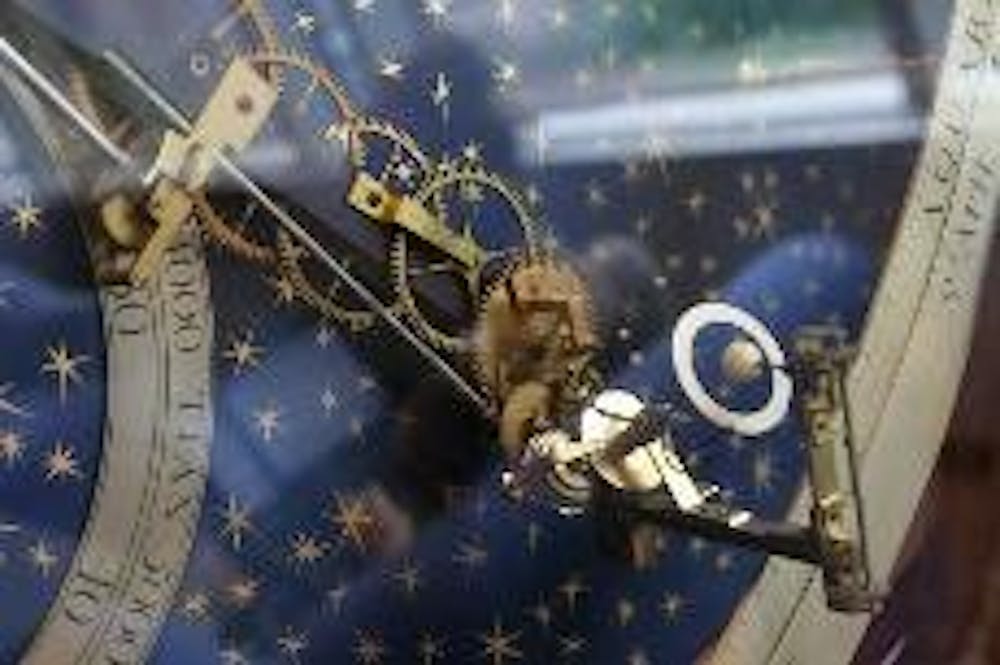It's one of the most valuable and unique pieces in Penn's art collection, but chances are you've never even heard of it, let alone noticed it tucked away in a corner of Van Pelt Library's first floor.
Penn's Rittenhouse Orrery is a model of the solar system, complete with accurately moving planets, and is as precise as was possible in the late 18th century, according to Bob Koch, a retired astronomy professor who has researched the orrery.
"Imagine that you are at some place an indefinite distance away, not looking only at the earth, [but] looking at the whole solar system," Koch said. "As you would turn the crank [to wind the device], the moon would revolve around the earth, and each of the planets would move around the sun at their own rates."
One aspect of the orrery you probably do recognize is its namesake, David Rittenhouse, whose name also graces a lecture hall and laboratory on Penn's campus.
Rittenhouse, a mathematician and scientist who later became an astronomy professor at Penn, built the device in 1771.
The device is named after Charles Boyle, the fourth earl of Orrery and the first individual to commission an orrery.
The middle of the device's three cabinets houses the solar system model, and the right cabinet represents the phases and the motion of the moon, Pollack said. The left side was supposed to show the movement of Jupiter and Saturn, but was never completed.
But Penn's model wasn't Rittenhouse's first orrery.
His first device was constructed and sold to the College of New Jersey, now Princeton University, shortly before Penn got its model.
"This orrery harkens back to a good, old Penn-Princeton rivalry that existed even in the 18th century," said John Pollack, public services specialist at the Rare Book and Manuscript Library. But "the Princeton orrery suffered some damage during the [American] Revolution, which is not the case for ours."
Although Pollack said the orrery is "a very famous piece of American science," there is no evidence showing that it was actually used for teaching purposes, Koch said.
David Rittenhouse was an "unsuccessful teacher" and an "expressionless person" who did not enjoy teaching, Koch said, offering some explanation as to why the orrery was not used for instruction.
Today, its value is certainly large but hard to estimate because of the device's unique nature.
"It is priceless," Koch said. "If you put that thing on the antiquities market, you would be looking at many millions."
Ken Hoffman, executive director of the University's Office of Risk Management and Insurance, declined to release the value at which the orrery has been appraised for insurance purposes, but said that it is among the most valuable pieces in the standing art collection.
It's not only the mechanisms of the orrery that make it valuable.
The Chippendale case, built by cabinetmakers John Folwell and Parnell Gibbs, has been preserved exquisitely and is probably responsible for keeping the hundreds of gears in the device's inner workings intact.
"Even for people who don't care anything about the science, the craftsmanship of the woodwork is an important thing too," Pollcak said.
In the 1970s, he added, the orrery was successfully wound and put back into working order. It remains unclear as to why the University and library administrators had discontinued winding the model.
One possible explanation, however, is that different methods have evolved for teaching astronomy, and technology has improved in ways that Rittenhouse himself probably never would have imagined.
And although the orrery probably remains unknown to most students, the library staff consider it important and noteworthy.
Laurie Allen, a research and instructional services librarian, said her colleagues used to publish and circulate a regular newsletter called The Orrery.
The librarians' internal Web log has a background with the wheels and cogs of an orrery, she added.
"We actually value it tremendously," Allen said.



